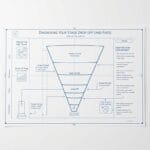The US Small Business Association says B2C companies spend a bit more on marketing than B2B ones. New businesses should also spend more to get noticed and draw in customers. Many small businesses plan to spend 2% to 5% of their revenue on marketing.
But, the exact amount you’ll need can change a lot. It depends on your business goals and marketing plan. Last year, marketers spent 10.4% more on marketing, which is twice as much as the year before. Also, marketing budgets make up about 11.7% of all budgets, according to Deloitte’s February 2022 survey.
Key Takeaways
- The average small business marketing budget is 2-5% of total revenue.
- B2C companies typically spend more on marketing than B2B companies.
- Startups and new businesses should allocate more for initial marketing efforts.
- Marketing spending has increased significantly in the past year.
- The amount you’ll need to invest can vary based on your specific business goals and strategies.
Understanding the Average Marketing Budget for Small Businesses
When looking at small business marketing budgets, a few key points stand out. The US Small Business Association suggests that B2C companies should spend a bit more on marketing than B2B companies. This is because B2C companies need to work harder to build brand awareness and draw in new customers.
For startups and new businesses, it’s smart to put a bigger part of your budget into marketing. This helps you make a strong mark in the market and start bringing in leads and sales. As your business grows, you can often cut back on marketing costs while still keeping your promotional efforts strong.
Cost-Effective Advertising Methods for Small Businesses
Small businesses have many cost-effective advertising methods to use to make their marketing budget go further. Some top choices include:
- Using social media for both free and paid ads
- Starting email marketing to connect with current customers
- Joining local events and sponsoring them
- Improving your website to show up better in searches
- Trying out frugal marketing plans and a bootstrap marketing approach
The goal is to pick the right mix of marketing channels that fit your business goals and budget. With smart planning and creativity, small businesses can promote their offerings well without spending a lot.
Setting Clear Marketing Goals and Objectives
Before diving into affordable marketing strategies or low-cost marketing ideas, small businesses must set clear goals. These goals could be to increase sales, get more leads, boost website traffic, or get more phone calls. It’s important to set SMART—specific, measurable, achievable, relevant, time-bound—goals first. This helps decide the marketing budget.
After setting your marketing priorities, you can look into inexpensive promotion techniques and marketing on a shoestring budget. This way, you make sure your limited resources work best, making the most of your affordable marketing strategies.
- Identify your main marketing goals (e.g., increase sales by 20%, get 50 new leads per month)
- Make sure your goals are SMART—specific, measurable, achievable, relevant, and time-bound
- Link your marketing goals with your overall business strategy and growth plans
- Keep checking and adjusting your goals as your business changes
“Clearly defined marketing goals are the foundation for any successful affordable marketing strategy.”
By setting clear, measurable marketing goals, Macro Webber and other small businesses can use their low-cost marketing ideas and inexpensive promotion techniques well. This leads to real results and growth.
Researching Industry Trends and Competition
For small businesses, digging deep into industry trends and checking out the competition is key. It helps you find the best ways to advertise without spending a lot. This smart way of marketing lets you use your money wisely.
Understanding B2B vs. B2C Marketing Budgets
B2B and B2C companies have different marketing budget needs. B2B firms spend less on marketing because they have sales teams that go after customers. B2C companies, however, spend more because they don’t have a team to promote their products.
| Industry | Average Marketing Budget |
|---|---|
| B2B | Lower |
| B2C | Higher |
Knowing these trends helps small businesses plan their marketing better. They can make their marketing work harder and spend less.

“Researching your competition and industry trends is crucial for small businesses to make informed decisions and stay competitive in the market.”
At Macro Webber, we think knowing your industry and competitors is key to marketing success. By using smart, cheap ways to promote, small businesses can reach their audience and grow.
Calculating Marketing Costs as a Percentage of Revenue
Finding the right marketing budget for your small business is tricky. Many entrepreneurs aim to spend 2% to 5% of their revenue on small business marketing budget. But, the right amount depends on your industry, growth stage, and marketing goals.
For marketing expenses for startups, spending more on building brand awareness and getting new customers is common. Yet, established businesses might use cost-effective advertising methods and frugal marketing plans. This helps them keep their marketing budget low as a percentage of revenue.
Industry Insights
B2C companies usually spend more on marketing than B2B ones. This is because B2C businesses often use ads and promotions to reach their target audience directly. B2B firms, however, might spend less on marketing. They have sales teams that actively look for and build relationships with potential customers.
The ideal marketing budget for your small business depends on many things. These include your industry, growth stage, and business goals. By looking closely at your small business marketing budget, you can create a frugal marketing plan. This plan helps you get the most out of your marketing spending.
“The most successful entrepreneurs I know are obsessive about marketing. They’re constantly thinking about new ways to spread the word about their business.”
Estimating Potential Marketing Expenses
As a small business owner, it’s key to think about all the costs in your marketing. At Macro Webber, we know how vital a bootstrap marketing approach is. We look for low-cost marketing ideas and inexpensive promotion techniques to stay competitive on a shoestring budget. By planning for these costs, you can make a marketing plan that fits your business goals and budget.
When figuring out your marketing expenses, consider these factors:
- Payments to marketing agencies or consultants
- Salaries or wages for in-house marketing employees
- Costs of various marketing campaigns and tactics, such as social media advertising, content creation, email marketing, and more
- Expenses for marketing equipment, tools, and software
Looking at each cost helps you make a detailed marketing budget. This way, your low-cost marketing ideas and inexpensive promotion techniques work well within your bootstrap marketing approach and marketing on a shoestring budget.
“Successful marketing is not about luck, it’s about planning, strategy, and execution.”
The secret to great small business marketing is finding the right balance. With a solid plan and a focus on low-cost marketing ideas and inexpensive promotion techniques, you can make a bootstrap marketing approach that helps your business grow and succeed.
Evaluating Past Marketing Performance and ROI
As a small business owner, it’s key to check how well your affordable marketing strategies, cost-effective advertising methods, and frugal marketing plans are doing. This helps you make smart choices for your budget and avoid spending on things that don’t work.
It’s important to keep an eye on key performance indicators (KPIs) to see how your marketing is doing. Look at things like website visits, new customers, sales, and how much money you make. This way, you can see which campaigns and channels work best for your Macro Webber business.
| Marketing Channel | Cost | Leads Generated | Conversion Rate | Revenue Attributed | ROI |
|---|---|---|---|---|---|
| Social Media Advertising | $500 | 50 | 10% | $2,000 | 300% |
| Email Marketing | $200 | 30 | 15% | $1,500 | 650% |
| Search Engine Optimization | $1,000 | 80 | 12% | $3,000 | 200% |
By keeping an eye on how well your marketing is doing and what you’re getting back, you can make smart choices for the future. This means you can make the most of your affordable marketing strategies, cost-effective advertising methods, and frugal marketing plans. This will help your Macro Webber business grow.

“Measuring the performance of your marketing efforts is crucial to ensuring you’re getting the best return on your investment.”
how much does marketing cost for small business
Small businesses spend a lot on marketing, and the cost can change a lot. The usual budget is 2% to 5% of their total revenue. But, it can be more or less depending on the business’s needs.
Startups and new small businesses often spend more. They need to make people know about them and get their first customers. They might spend on a website, social media, and ads.
Established small businesses with customers already might spend less. They focus on cost-effective advertising methods, frugal marketing plans, and a bootstrap marketing approach.
The small business marketing budget depends on several things:
- Revenue and industry
- Stage of business and growth goals
- Target audience and competition
- Marketing channels and strategies being used
At Macro Webber, we help small businesses make a cost-effective marketing plan that fits their budget and goals. Call us at +91 (353) 405-7665 or email hello@macrowebber.com to find out more.
There’s no single answer for small business marketing costs. By knowing what you need and want, you can make a frugal marketing plan that gives you the best value for your money.
Considering Stage of Business and Growth Goals
For startups, your marketing budget is very different from that of established small businesses. Startup companies need to invest a lot in marketing at the beginning to get noticed and draw in customers. This means spending on things like a professional website, social media, and sometimes paid ads.
When you’re just starting, marketing on a shoestring budget is key. Use low-cost marketing ideas and inexpensive promotion techniques to kickstart your bootstrap marketing approach. Think about content marketing, email outreach, getting involved in your community, and forming strategic partnerships.
As your business grows, you can tweak your marketing expenses for startups to focus on better and cheaper strategies. It’s important to know where your business is in terms of growth and set your marketing goals and budget accordingly. This way, you make sure you’re using your money wisely to meet your business goals.
“The stage of a small business’s growth has a significant impact on its marketing budget. Understanding the stage of the business and its growth goals is crucial in determining an appropriate marketing budget.”
Allocating Budgets Across Different Marketing Channels
At Macro Webber, we know small businesses need to use their marketing budgets wisely. This means using affordable marketing strategies, like cost-effective advertising methods and inexpensive promotion techniques. A frugal marketing plan or bootstrap marketing approach can also be helpful.
By knowing the costs and effects of each marketing method, small businesses can make a strong marketing plan within their budget. This plan might include digital marketing like SEO, social media, and email. It could also include traditional methods like print ads, direct mail, and networking.
Prioritizing Digital and Traditional Marketing
It’s key to balance between digital marketing and traditional marketing when setting your budget. Digital marketing can be more measurable and cost-effective. But traditional marketing is still important for building brand awareness and reaching certain audiences.
- Put some of your budget into digital marketing tactics, like SEO, social media ads, and email marketing.
- Use some of your budget for traditional marketing, such as print ads, direct mail, and networking events.
- Keep an eye on how your marketing is doing and change your budget as needed.
| Marketing Channel | Estimated Cost | Potential Impact |
|---|---|---|
| Search Engine Optimization (SEO) | $500 – $5,000 per month | Increased website traffic and visibility |
| Social Media Advertising | $500 – $2,000 per month | Targeted brand awareness and lead generation |
| Email Marketing | $100 – $500 per month | Nurture existing customer relationships |
| Print Advertising | $1,000 – $10,000 per campaign | Increase brand visibility and credibility |
| Direct Mail | $0.50 – $5 per piece | Targeted lead generation and customer acquisition |
| Networking Events | $50 – $500 per event | Build relationships and generate referrals |
The key to great marketing for small businesses is to try, measure, and keep improving your budget across channels. By using data and a strategic approach, you can make the most of your frugal marketing plan. This way, you can reach your business goals.
“The most successful small businesses are the ones that have a well-rounded marketing strategy that leverages both digital and traditional channels.”
Conclusion
Figuring out the right marketing budget for your small business at Macro Webber takes thought. You need to look at your revenue, industry, business stage, target customers, competition, and marketing goals. Knowing the usual marketing costs and budgets for small businesses helps. With a strategic and data-driven marketing plan, you can use your resources well to grow your company and reach your audience.
Looking for affordable marketing strategies or ways to manage startup marketing costs? Macro Webber can guide you. We offer cost-effective advertising methods and inexpensive promotion techniques. Our frugal marketing plans and bootstrap marketing approach help you grow without spending too much.
Want to learn more about how we can help you with marketing costs for small businesses? Contact Macro Webber today at +91 (353) 405-7665 or hello@macrowebber.com. Let us help you unlock your full potential.



